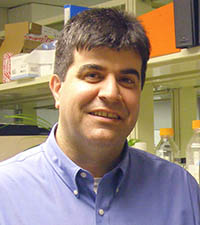Dr. Charles S. Sfeir

Associate Professor
University of Pittsburgh
School of Dental Medicine
Department of Oral Biology
552 Salk Hall, 3501 Terrace Street
Pittsburgh, PA 15261
Telephone: 412-648-1949
Fax: 412-624-6685
Education:
D.D.S./1990 - Dental Medicine, University Louis Pasteur, Strasbourg, France
Certificate/1995 - Periodontal Residency, Northwestern University, Chicago, IL
Ph.D./1996 - Molecular Biology, Northwestern University, Chicago, IL
Research Interests:
- Role of Dentin Matrix Protein in Biomineralization and Tissue Engineering: General concepts of biomineralization and role of non-collagenous proteins in tissue engineering. Biomineralization is a diverse, yet common phenomenon. It refers to the processes by which organisms form minerals. A wide variety of living organisms possess mineralized tissues, such as bone, dentin and cartilage. In biologically induced mineralization, the mineral crystals are produced by heterogeneous nucleation. The affinity of extracellular matrix constituents for ions may control the formation of initial mineral deposits (nucleation). Nucleation may regulate the size, morphology, and orientation of resulting crystals (crystal growth). We will focus on the hydrated extracellular organic matrix that is composed primarily of proteinaceous macromolecules. In particular, the phosphorylated proteins of the mineralized matrix, such as phosphophoryns (PP) and bone sialoproteins.
- Gene Delivery to the injured pulp: During mechanical cutting of tooth structure, exposures of the pulp chamber can occur. The traditional means of treatment is to perform a direct pulp capping procedure. This involves applying a layer of calcium hydroxide to the exposed area, followed by a covering layer of glass ionomer cement. This mode of therapy is not yet predictable. When calcium hydroxide is applied directly to pulp tissue, necrosis of the adjacent pulp tissue and inflammation of the contiguous tissue occurs. Dentin bridge formation occurs at the junction of the necrotic tissue and the inflamed tissue. We propose to induce the formation of the dentin bridge using gene therapy. This will research will apply tissue engineering principles for dentin structures.
- Ink Jetting of Nanostructured Materials for Controlled Gene Delivery: The goal of this research is to create novel nanotechnology processes that will enable the manufacture of safe and effective gene delivery therapies for bone tissue engineering applications. Gene delivery can be achieved using non-viral (plasmid) techniques that are desirable because they are economical and low in toxicity, but are currently limited by low transfection efficiencies. The proposed research is aimed at developing a novel non-viral gene delivery carrier (nanocarrier) based on exploiting the nanoscale phenomena of materials that provide for improved transfection efficiencies through dramatically increased surface-active DNA binding sites and enhanced reactivity triggered by reduced materials dimensionality.
- Dental Pulp Stem Cells Characterization: The project will use multipotent stem cells that reside in the human adult dental pulp as an alternative autologous cell source to mesenchymal stem cells (MSCs) derived from bone marrow aspirates, adipose tissue, or umbilical cord blood. The interest in using dental pulp tissues for stem cell source, such as those in the adult third molars, is that they are easily accessible, their lineage is different than bone marrow mesenchymal stem cells and could possibly provide us an understanding of osteoblast and odontoblast differentiation in the craniofacial region. The project will characterize and identify pericytes as a unique population of dental pulp stem cells that can be sorted and expended for cell mediated therapies.
Resume

